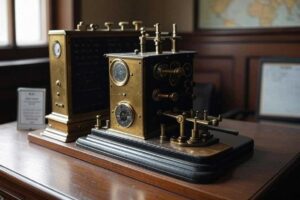You may not have heard of it, but you have likely seen it. So, what is semaphore anyway? It is a form of communication that uses visual signals to convey messages over long distances, a method that dates back to ancient times and has evolved through history. Whether through flags, movable arms on towers, or other means of visual signals, this system has played a significant role in human communication, particularly in the maritime world and during times of war. But what exactly is semaphore, how does it work, and does it still have a place in today’s world of cellular phones and fax machines? This blog post explores the origins, mechanics, and modern relevance of the communication method, both in its traditional flag-based form and its digital counterpart in computing.
Origins and Evolution
The very word “semaphore” comes from the Greek terms sema (sign) and phoros (bearer), meaning “sign bearer.” In ancient times, visual messaging systems like smoke signals or a form of torches were used to send messages across vast distances, often relying on a horse-riding messenger to relay information between points. However, the semaphore system as we know it began to take shape in the late 18th century during the French Revolution, thanks to the work of Claude Chappe.
Chappe, a French engineer, developed the optical telegraph in 1792, a system that used large towers equipped with movable arms to transmit messages. Known as Chappe’s design, these towers had large blades or arms that could be positioned in various fixed positions to represent different messages or letters of the alphabet. Each tower relayed the message to the next tower in a chain, allowing the French government to send messages across the country quickly. This was one of the fastest systems of its time, capable of transmitting a message from Paris to Lille—a distance of about 140 miles—in just a few minutes. The system was later used during the Napoleonic Wars to coordinate military movements, proving its value as a primary source of communication.
In the United Kingdom, the concept of semaphore was explored as early as 1669 by Robert Hooke, a member of the Royal Society, who proposed a visual signaling system. However, it wasn’t until the 19th century that it became widely used, particularly in naval applications. The maritime world adopted flag semaphore, a system of flags that could convey messages using hand-held flags or short poles. This method became a very useful tactic during naval history, notably at the Battle of Trafalgar in 1805, where Admiral Horatio Nelson famously used signal flags to send the message “England expects that every man will do his duty.”
How it Works: Flags and Towers
Semaphore, in its most recognizable form, involves flag semaphore, where a flag bearer uses two square flags—often maritime use flags like the Oscar flag—to send messages. These hand flags, typically attached to small dowels or dowel rods, are held in different positions to represent the letters of the alphabet or numbers. The semaphore alphabet assigns a unique combination of flag positions to each letter, with the position of the flags corresponding to angles on a clock face. For example, holding the right arm straight up and the left arm straight down might represent the letter “A,” while other various positions of the right hand and left hand could signal different letters.
The principle of flags in semaphore is simple yet effective. A flag bearer stands in a rest position with both flags down, then raises them to specific angles to form semaphore signals. These flag positions are interpreted by another person at a distance, often on a ship or at a shore station, who decodes the message. In terms of circles, the arms are positioned at angles resembling the hours on a clock face—12 o’clock, 3 o’clock, 6 o’clock, and so on. This easy method allowed sailors to communicate over long distances without the need for verbal communication, making it a vital tool in the United States, the United Kingdom, and other naval powers during World War II and earlier conflicts like the Napoleonic Wars.
On land, semaphore stations with large towers and movable arms were used, similar to Chappe’s design. These semaphore towers, often equipped with lever frames to adjust the arms, could send messages across vast distances by relaying signals from one tower to the next. This optical telegraph system was a precursor to the first proposals of the electrical telegraph by Samuel Morse (often spelled Samual Morse in historical texts), which eventually replaced semaphore as a faster and more reliable form of communication.
Maritime
In the maritime world, flag semaphore became a cornerstone of communication. Ships used hand signals with flags to communicate during underway replenishment or to coordinate maneuvers in battle. The system was also used on land for land use purposes, such as signaling between military outposts or coastal stations in places like Ocean City. Semaphore signals were particularly valuable in emergency situations, where they served as a form of emergency communication when other methods failed.
Interestingly, semaphore flags also found a place in cultural history. Gerald Holtom, a British conscientious objector, drew inspiration from the semaphore alphabet when designing the peace sign in 1958. Holtom, who created the symbol for a nuclear disarmament protest march, based it on the semaphore signals for the letters “N” (nuclear) and “D” (disarmament), with the right arm and left arm positions forming the now-iconic circle and lines.
However, the rise of technologies like Morse code, developed by Samuel Morse, and later the telegraph, fax machines, and cellular phones, made traditional semaphore less necessary. By the 20th century, these faster systems had largely replaced semaphore as the primary means of visual signals in most contexts.
Computing
While traditional semaphore may seem like a relic of the past, the concept has found new life in the digital age through the binary semaphore in computing. In computer science, a semaphore is a synchronization mechanism used to manage access to a shared resource, such as processor cores or instances of a resource in a program. The binary semaphore, in particular, acts as a flag that can be in one of two states—0 or 1—controlling access to a critical section of code.
For example, in a producer-consumer problem, a semaphore ensures that the producer and consumer threads do not access the shared resource simultaneously. The semaphore count determines whether the resource is available, and operations like the P operation (to acquire the resource) and condition variables help manage access. This modern use of semaphore demonstrates how the principle of flags—signaling availability or unavailability—has evolved into a critical tool for managing potential dangers in computing, such as race conditions or data corruption.
Is Semaphore Still Used Today?
So, is semaphore still used today? In its traditional form, semaphore with hand-held flags or semaphore towers is largely a historical artifact. The advent of faster communication technologies, from the telegraph to cellular phones, has rendered it obsolete for most practical purposes. However, flag semaphore is still taught in some naval training programs as a backup form of communication in emergency situations, particularly when electronic systems fail. For instance, during power outages or in remote areas where modern technology is unavailable, semaphore signals can still be a viable means of visual communication.
In the maritime world, while signal flags are still used for certain protocols, most communication now relies on radio or satellite systems. Yet, the legacy of semaphore lives on in cultural practices and historical reenactments. Organizations in the United States and the United Kingdom occasionally demonstrate flag semaphore at historical events, preserving its place in naval history.
In the digital realm, the concept of semaphore remains very much alive. Binary semaphores and their variations are integral to operating systems and software development, ensuring that multiple processes can safely share resources like processor cores. This modern application shows how an ancient form of communication has adapted to the needs of the 21st century.
Today, semaphore may not be the fastest system for communication, but its historical significance and niche applications ensure that it remains a part of our shared heritage. Whether as a backup in emergency situations or a concept in computer science, semaphore proves that even the oldest forms of communication can find new relevance in a rapidly changing world.
Related:
Photo by WikiCommons


